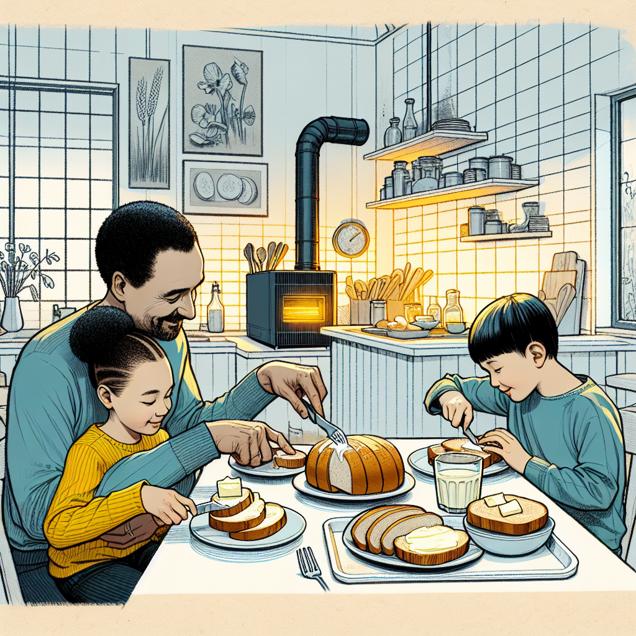Spurious Correlations (original) (raw)
correlation is not causation
random · discover · next page →
don't miss spurious scholar,
where each of these is an academic paper


Minds Over Matter: The Psych-ing Connection Between Bachelor's Degrees in Psychology and Groundskeepers in Utah
Show GenAI's made-up explanation As the number of psychology graduates rose, so did the demand for shrinks, er, I mean shrub experts. It seems like everyone was finally recognizing the deep-rooted issues in Utah's green spaces and decided to take a leaf out of Freud's book by tackling them head-on. As these graduates mulled over their career options, they realized that they could cultivate a fulfilling career in groundskeeping, digging deep into the soil of the human psyche while also mowing lawns. It's a Freudian field of work indeed, where they can help grass cope with its existential crises and provide much-needed therapy for plants experiencing growth issues. It's safe to say that these psychology grads are really raking in the success in the world of horticulture, proving that when it comes to tending to the state of Utah's landscapes, they're not just whistling dixie!
Show GenAI image
Show scatterplot
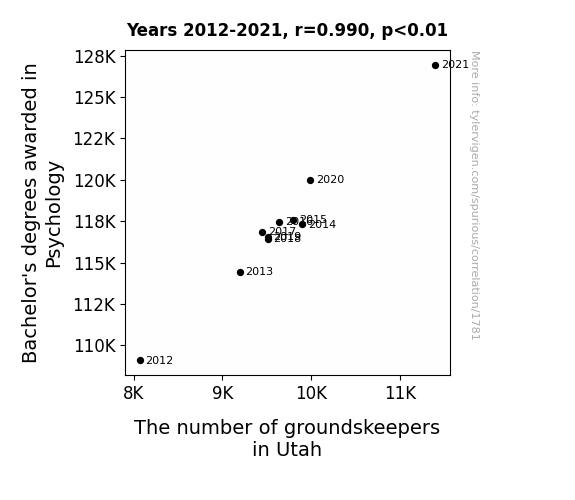


Brewing Up a Solar Storm: The Surprising Relationship Between U.S. Breweries and Solar Power Generation in Peru
Show GenAI's made-up explanation As the number of breweries in the United States increased, so did the demand for beer. This led to a surge in hop production, creating a need for more agricultural labor in Peru. With more people working outdoors, the Peruvian solar power industry experienced a boost in productivity from all the extra sunshine beer as the real power source!
Show GenAI image
Show scatterplot
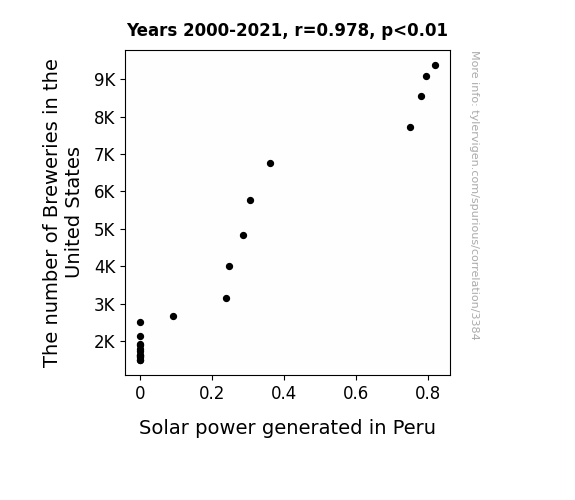


Dewey Decimals and Dingers: Exploring the Relationship Between Library Science Bachelor's Degrees and Oakland Athletics Ticket Sales
Show GenAI's made-up explanation As the number of library science graduates rises, so does the world's appreciation for organization and categorization. This heightened sense of order subtly influences baseball fans, leading to a greater desire to see the players neatly 'cataloged' on the field. It's like the Dewey Decimal System of entertainment - everyone just wants to 'check out' a game! Plus, with their finely honed research skills, these grads may have uncovered the hidden 'book' on how to win at baseball, making the Athletics games a hot ticket!
Show GenAI image
Show scatterplot
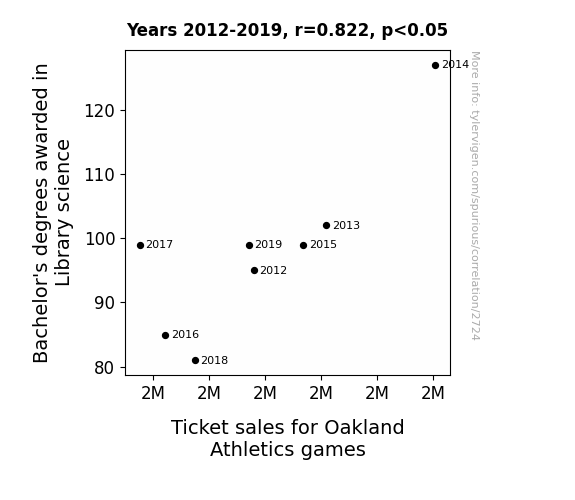


Smell in the Air: Exploring the Fertilizing Effects of Dried Manure on Customer Satisfaction with Target
Show GenAI's made-up explanation As the dried manure supply dwindled, farmers had to get creative with their fertilizer choices. This led to an increase in the use of unconventional fertilizers, ultimately affecting the aroma around Target stores. In other words, as the manure decreased, so did the 'manure-ity' of the shopping experience at Target. This correlation stinks!
Show GenAI image
Show scatterplot



The Magic of Public Transit: Conjuring the Connection Between Transit Police Numbers in Texas and Google Searches for 'how to do magic'
Show GenAI's made-up explanation Without transit police around, there were fewer people to saw in half during their magic acts, leading to a decline in interest in magic tricks and illusions. Guess the real disappearing act is the interest in magic!
Show GenAI image
Show scatterplot
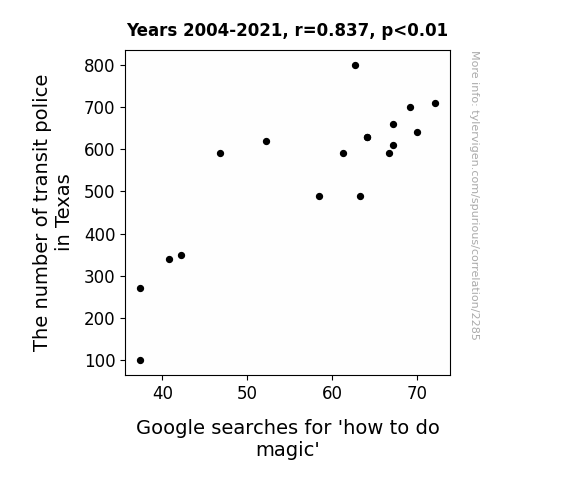


Amaizeing Connections: Analyzing the GMO Effect on Corn and Its Impact on Enbridge's Stock Price
Show GenAI's made-up explanation As the GMO corn in Michigan proliferated, it developed a secret ability to emit tiny amounts of positive energy, inadvertently boosting the stock price of Enbridge. It seems their corny connection led to a-maize-ing results for the stock market! Corn-gratulations, GMOs!
Show GenAI image
Show scatterplot
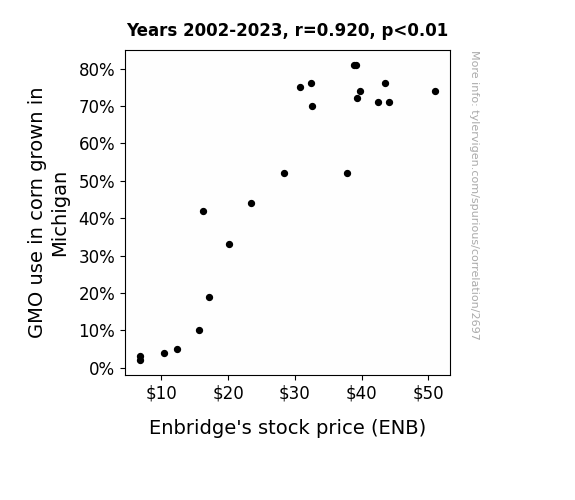


Shine a Light on the Connection: Master's Degrees in Communication, journalism, and related programs and Solar Power Generation in Malta
Show GenAI's made-up explanation As more people mastered the art of communication, they were able to convince the sun to shine brighter and longer specifically on Malta. It turns out, the real power of journalism and communication lies in influencing celestial bodies!
Show GenAI image
Show scatterplot
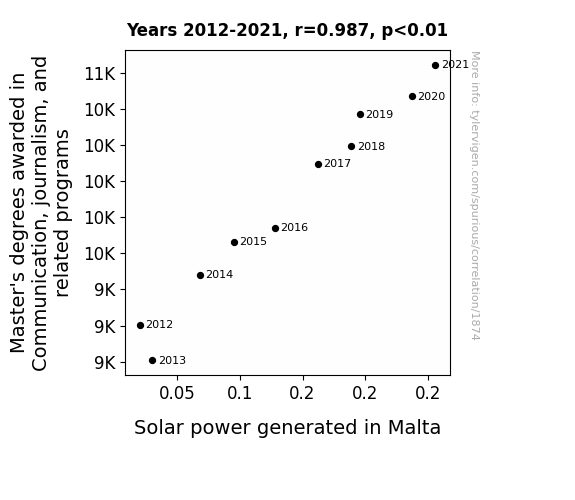


The Sarah Effect: Surprising Association of Sarah's Popularity and Sizable Amazonian Arboreal Attendance
Show GenAI's made-up explanation As the popularity of the name Sarah waned, so too did the number of Sarahaus trees, a rare and beloved species found only in the Brazilian Amazon. Local legend has it that these trees whispered the name "Sarah" every time a woodcutter approached, leading to a swift and unintentional protection of the remaining forest cover. Remember, every time a Sarah loses its 'h', a Sarahaus tree loses its leaves!
Show GenAI image
Show scatterplot



The (Non) Noble Nexus: Navigating the Nexus between Google Searches for 'Matt Levine' and The Number of college administrators in Ohio
Show GenAI's made-up explanation As more people delved into the world of finance through Matt Levine's writings, they were inspired to apply their newfound knowledge in unexpected ways. This led to a surge in individuals creating their own financial theories, prompting colleges in Ohio to hire additional administrators to review and integrate these unconventional ideas into their academic programs. It's a case of Matt-ematical expansion in the education sector!
Show GenAI image
Show scatterplot
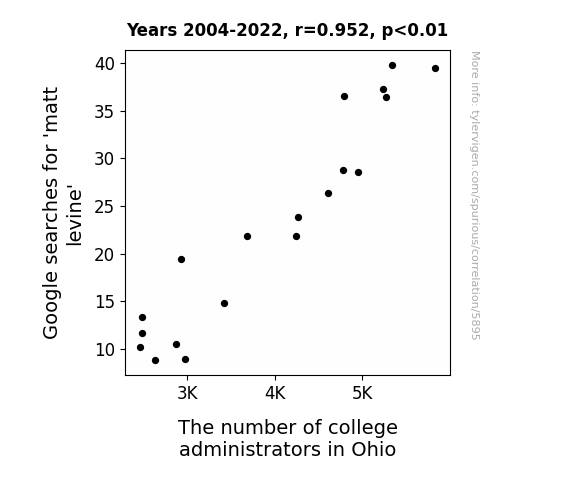


The Big Score: Analyzing the Reel Connection Between Steinfeld Cup Final Teams and Box Office Booms
Show GenAI's made-up explanation As the difference in score decreased, fans of the losing team were feeling more down, leading to a decrease in overall enthusiasm. This disparity in team performance really affected the box office, creating a net loss in ticket sales for the top movie of the year. We can say it really threw a 'fowl' on the whole movie-going experience.
Show GenAI image
Show scatterplot
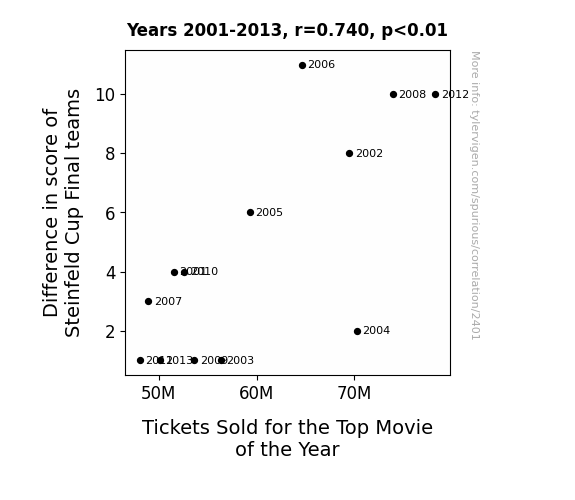


Spreading Power: Uncovering the Butterly Connection Between Butter Consumption and Biomass Power Generation in Lithuania
Show GenAI's made-up explanation The extra butter intake led to an increase in flatulence, creating more methane for biomass power generation in Lithuania. Looks like butter really is the greener spread!
Show GenAI image
Show scatterplot
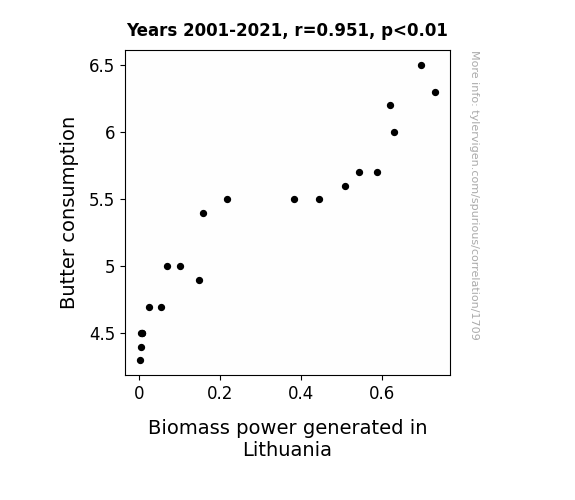


The Wheezy Woes of Tristen: A Statistical Analysis of the Link between Tristen's Popularity and Asthma Attacks in American Children
Show GenAI's made-up explanation Fewer Tristens meant less air was being taken up by dramatic sighs, thereby reducing the overall respiratory distress in the country.
Show GenAI image
Show scatterplot
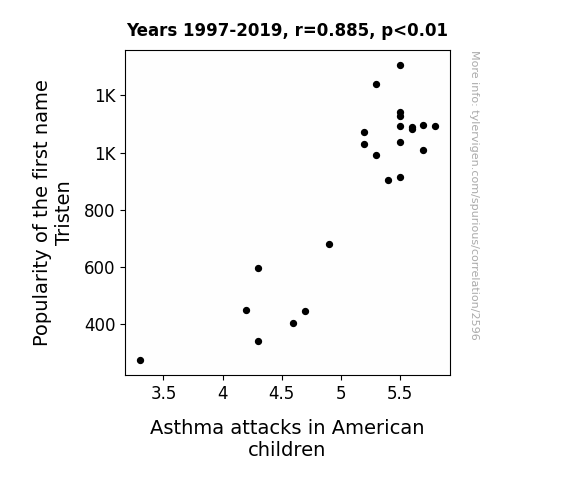


LockPickingLawyer's Clickbait Capers and the 'Y U No' Meme: A Hip Connection Analysis
Show GenAI's made-up explanation As the 'y u no' meme started to fade, it took with it the very essence of hipness, leaving the LockPickingLawyer feeling oddly less trendy with each video he titled. It seems the meme magic was the key to his coolness all along. Remember, when it comes to internet culture, memes may come and go, but the adept art of lock picking is always on trend!
Show GenAI image
Show scatterplot
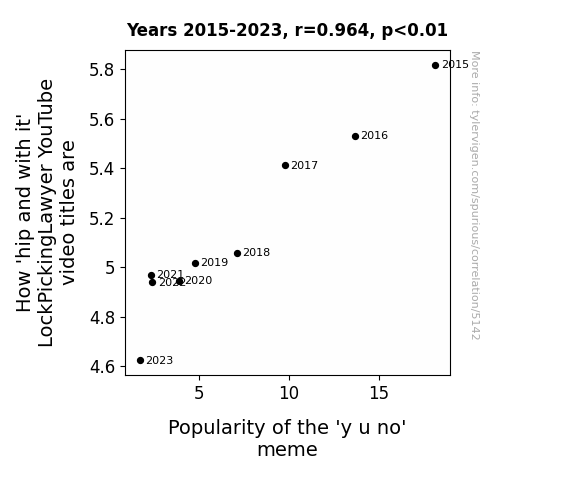


Associates Awards in Adjudication: An Analysis of the Alleged Impact on Cenovus Energy's Stock Price
Show GenAI's made-up explanation As the number of legal associates dwindled, there was a sharp rise in courtroom antics. With fewer qualified professionals, the legal system became a full-blown circus. Amidst all the chaos, Cenovus Energy found themselves in the middle of a ridiculous lawsuit. It turns out, the case revolved around the rights to a long-lost, highly sought-after oil well, which was accidentally built upon by a clown academy. The whole debacle not only drained Cenovus Energy of resources but also left investors juggling their priorities, ultimately leading to a slippery slope for their stock price.
Show GenAI image
Show scatterplot
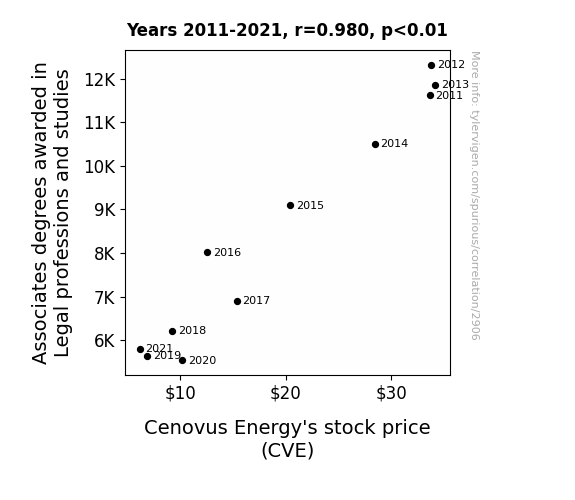


Franklin, My Dear Watson: Exploring the Fickle Nature of Names and TV Fame in 'Two and a Half Men' Season Ratings
Show GenAI's made-up explanation Every time someone named Franklin tuned in to watch, they couldn't help but laugh at all the puns and dad jokes, creating a subconscious laugh track that boosted the ratings. Additionally, the influx of Franklins sparked a new fan theory that the show was secretly an allegory for Benjamin Franklin's life, leading to renewed interest and speculation. The name Franklin just had a magnetic pull on the success of the show, like a quirky sitcom magnet.
Show GenAI image
Show scatterplot
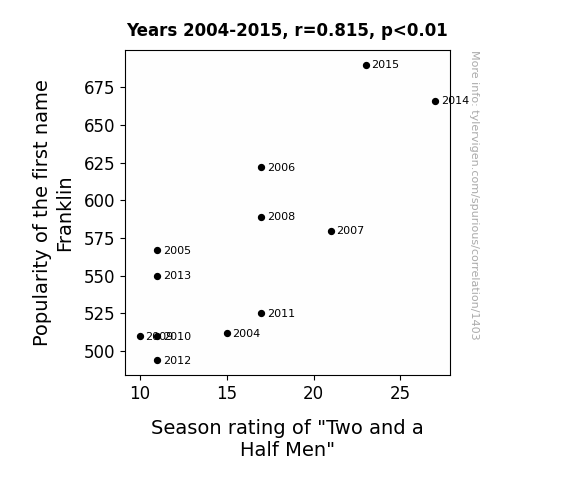


The Dirty Laundry of Travel Aspirations: Exploring the Relationship between US Household Spending on Cleaning Supplies and Google Searches for 'Flights to Antarctica'
Show GenAI's made-up explanation As US households spent more on laundry and cleaning supplies, they became obsessed with achieving the freshest, cleanest scent possible. This obsession extended to wanting the ultimate fresh air experience, leading people to search for flights to Antarctica, known for its crisp, pure air. After all, if your laundry smells like a refreshing polar breeze, why not experience the real deal, right? And who wouldn't want to see penguins rocking their spotless tuxedos in person? Maybe it's time for a new marketing slogan: "Antarctica: Because Freshness Matters!"
Show GenAI image

Show scatterplot
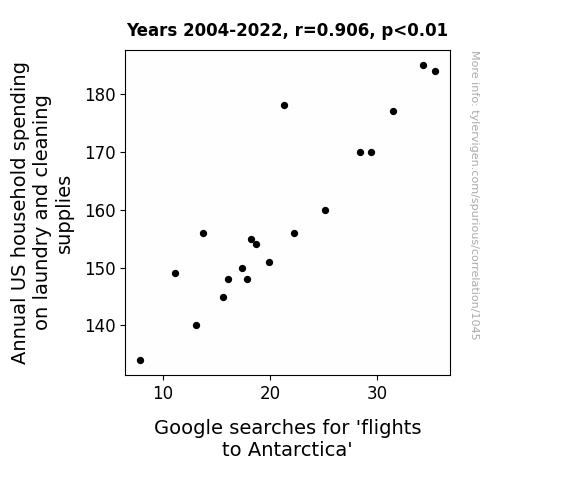


Putting the Surprised in Statistical Significance: An Examination of the 'Surprised Pikachu' Meme and its Impact on Middle School Teacher Population in Puerto Rico
Show GenAI's made-up explanation As the 'surprised Pikachu' meme gained traction, it led to an uptick in internet usage. This surge in online activity put a higher demand on the telecommunication infrastructure in Puerto Rico. To meet this demand, more tech companies invested in the region, creating job opportunities. With the expanding job market, there was a need for additional educators to support the growing number of families relocating to Puerto Rico. As a result, the popularity of the meme indirectly contributed to an increase in the number of middle school teachers in Puerto Rico.
Show GenAI image
Show scatterplot
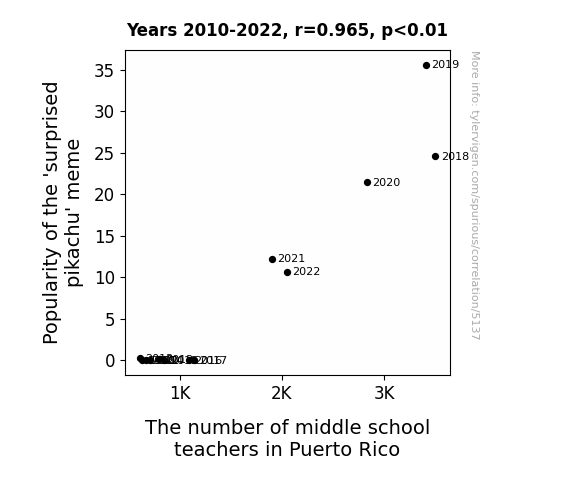


The Stellar Influence of Alanna: A Celestial Analysis of Name Popularity and Planetary Distance
Show GenAI's made-up explanation As more and more babies were named Alanna, the collective sound frequency of their parents proudly calling out to them created small but measurable sonic waves. Over time, these waves interfered with the gravitational pull between Uranus and Venus, inadvertently nudging them slightly further apart. The Alanna Effect, as it was dubbed by baffled astronomers, led to reevaluations of celestial mechanics and left everyone marveling at the cosmic consequences of baby name trends.
Show GenAI image
Show scatterplot
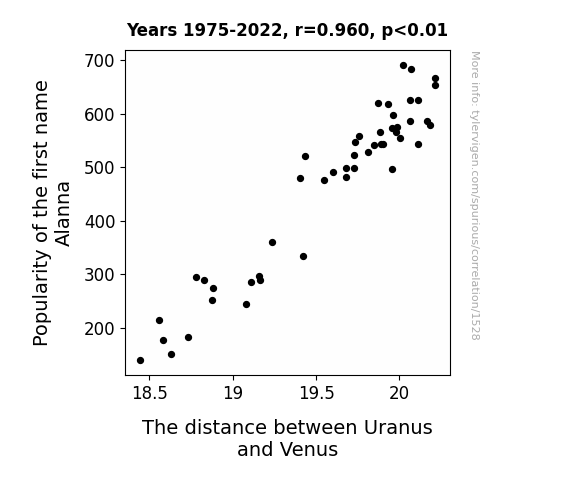


Spreading Love and Margarine: An Examination of the Butter-Splitter Correlation in Maine
Show GenAI's made-up explanation Perhaps as people used less margarine, they became less slippery in their relationships. The lack of artificial spread may have kept the couples from buttering each other up, leading to a decrease in overall marital strife. That's the reality when you can't believe it's not butter - it's a recipe for marital success. Alternatively, it could be that as the margarine consumption decreased, so did the overall slickness in the state, leading to fewer instances of partners feeling like they couldn't grip the marriage.
Show GenAI image
Show scatterplot
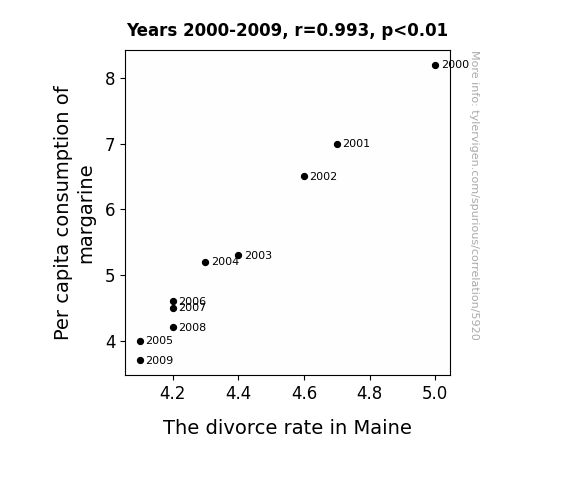
Why this works
- Data dredging: I have 25,237 variables in my database. I compare all these variables against each other to find ones that randomly match up. That's 636,906,169 correlation calculations! This is called “data dredging.”Note Fun fact: the chart used on the wikipedia page to demonstrate data dredging is also from me. I've been being naughty with data since 2014.
Instead of starting with a hypothesis and testing it, I instead tossed a bunch of data in a blender to see what correlations would shake out. It’s a dangerous way to go about analysis, because any sufficiently large dataset will yield strong correlations completely at random. - Lack of causal connection: There is probably no direct connection between these variables, despite what the AI says above.Note Because these pages are automatically generated, it's possible that the two variables you are viewing are in fact causually related. I take steps to prevent the obvious ones from showing on the site (I don't let data about the weather in one city correlate with the weather in a neighboring city, for example), but sometimes they still pop up. If they are related, cool! You found a loophole.
This is exacerbated by the fact that I used "Years" as the base variable. Lots of things happen in a year that are not related to each other! Most studies would use something like "one person" in stead of "one year" to be the "thing" studied. - Observations not independent: For many variables, sequential years are not independent of each other. You will often see trend-lines form. If a population of people is continuously doing something every day, there is no reason to think they would suddenly change how they are doing that thing on January 1. A naive _p_-value calculation does not take this into account.Note You will calculate a lower chance of "randomly" achieving the result than represents reality.
To be more specific: p-value tests are probability values, where you are calculating the probability of achieving a result at least as extreme as you found completely by chance. When calculating a p-value, you need to assert how many "degrees of freedom" your variable has. I count each year (minus one) as a "degree of freedom," but this is misleading for continuous variables.
This kind of thing can creep up on you pretty easily when using p-values, which is why it's best to take it as "one of many" inputs that help you assess the results of your analysis. - Y-axes doesn't start at zero: I truncated the Y-axes of the graphs above. I also used a line graph, which makes the visual connection stand out more than it deserves.Note Nothing against line graphs. They are great at telling a story when you have linear data! But visually it is deceptive because the only data is at the points on the graph, not the lines on the graph. In between each point, the data could have been doing anything. Like going for a random walk by itself!
Mathematically what I showed is true, but it is intentionally misleading. If you click on any of the charts that abuse this, you can scroll down to see a version that starts at zero. - Confounding variable: Confounding variables (like global pandemics) will cause two variables to look connected when in fact a "sneaky third" variable is influencing both of them behind the scenes.
- Outliers: Some datasets here have outliers which drag up the correlation.Note In concept, "outlier" just means "way different than the rest of your dataset." When calculating a correlation like this, they are particularly impactful because a single outlier can substantially increase your correlation.
Because this page is automatically generated, I don't know whether any of the charts displayed on it have outliers. I'm just a footnote. ¯\_(ツ)_/¯
I intentionally mishandeled outliers, which makes the correlation look extra strong. - Low n: There are not many data points included in some of these charts.Note You can do analyses with low ns! But you shouldn't data dredge with a low n.
Even if the p-value is high, we should be suspicious of using so few datapoints in a correlation.
Pro-tip: click on any correlation to see:
- Detailed data sources
- Prompts for the AI-generated content
- Explanations of each of the calculations (correlation, p-value)
- Python code to calculate it yourself










